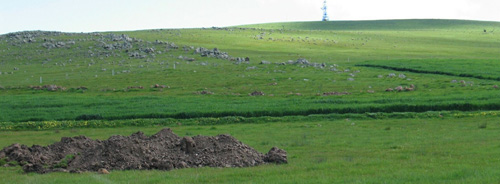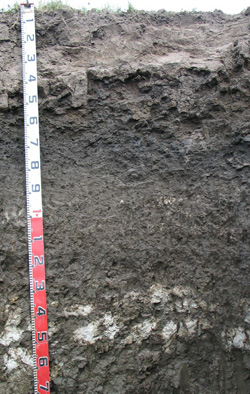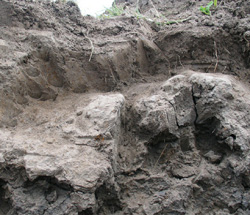SW109
Location: Mt Gellibrand.
Australian Soil Classification: Vertic (& Hypercalcic), Mottled-Mesonatric, Black SODOSOL (very deep soil profile).
General Landscape Description: Lower slope of Mt Gellibrand, northerly aspect.
Site Description: Grazing paddock. A flat area just at the foot of a steeper slope, with a basalt dyke or flow just up slope. Subject to soil creep and wash from above.
Geology: Late Quaternary basalt (Bartley 1984).
Soil Type: “Low slopes (lighter type)” (Leeper et al., 1936)

SW109 Landscape
Soil Profile Morphology:
Surface Soil
| A1 | 0-15 cm | Very dark greyish brown (10YR3/2); fine sandy loam; firm consistence dry; pH 6; clear change to: |  SW109 Profile SW109 Profile |
| A2 | 25-40 cm | Light grey (10YR7/1 dry) with yellowish brown (10YR5/4) rusty root channel mottling; conspicuously bleached; sandy loam; firm to very firm consistence dry; pH 6.2; sharp and wavy change to: | |
| Subsoil | |||
| B21 | 25-40 cm | Very dark grey (10YR3/1) with many brown (7.5YR5/4) rusty mottles; medium clay; strong coarse blocky structure; in parts there is strong very coarse columnar structure, with bleached capping associated with domes; strong consistence dry; pH 6.4; clear change to: | |
| B22 | 40-60 cm | Very dark grey (10YR3/1) with many brown (10YR5/4) mottles; medium heavy clay; strong coarse blocky, parting to moderate medium sub-angular blocky structure; strong consistence dry; slickensides present; pH 7.9; clear change to: | |
| B23 | 60-80 cm | Very dark grey (10YR3/1); heavy clay; strong coarse polyhedral structure; very firm consistence dry; slickensides present; pH 8.6; clear change to: | |
| B24 | 80-100 cm | Grey (2.5Y5/1); heavy clay; strong coarse prismatic, parting to strong coarse blocky structure; very firm consistence dry; few fine-earth carbonates and fine calcareous nodules (2-4 mm in size); slickensides present; pH 9.3; clear change to: | |
| B25 | 100-130 cm | Grey (10YR5/1) with very few yellowish brown (10YR5/6) mottles; medium heavy clay; strong coarse prismatic, parting to strong coarse sub-angular blocky structure; very firm consistence moist; few fine-earth carbonates and very few very coarse (up to 30 mm in size) ferruginous nodules; few weathered ferruginous basalt fragments (20 mm in size); slightly effervescent; smooth faced peds; pH 9.3; clear change to: | |
| B26k | 130-160 cm | Greyish brown (2.5Y5/2); heavy clay; strong coarse polyhedral structure; firm consistence moist; many fine-earth carbonates and semi-hard carbonate nodules, few very coarse (10-30 mm in size) ferruginous nodules; very few isolated ferruginous basalt cobbles (100 mm in size); visible carbonates; pH 9.7; gradual change to: | |
| B27k | 130-160 cm | Greyish brown (2.5Y5/2); heavy clay; strong coarse polyhedral structure; very firm consistence moist; very few fine (1-2 mm in size) soft and hard manganese nodules and few coarse (5-15 mm in size) ferruginous nodules; very few very fine (<1 mm in size) quartz fragments; slightly audible effervescence. | |
- Strong texture contrast between surface (A) horizons and subsoil (B21) horizon.
- Dense and coarsely structured upper subsoil (columnar in some areas).
- Accumulations of calcium carbonate in deeper subsoil.
- Vertic features (slickensides, lenticular structure) in subsoil.


Domes / columnar structure evident in the B21 horizon in some areas.
Soil Profile Characteristics:
pH | Salinity Rating | |||
Surface (A1 horizon) | Moderately Acid | Low | Non-Sodic | None1 |
Subsoil (B21 horizon) | Slightly Acid | Low | Strongly Sodic | Strong2 |
Deeper subsoil (at 80-100 cm) | Very Strongly Alkaline | Moderate - High | Strongly Sodic | Strong2 |

| The surface soil is moderately acid. The upper subsoil is slightly acid becoming very strongly alkaline at depth. |
|
| The clay content is moderate throughout the profile. |
Horizon | Horizon Depth (cm) | pH (water) | pH CaCl2 | EC dS/m | NaCl % | Total Nitrogen % | Organic Carbon % | Exchangeable Cations | |||
Ca | Mg | K | Na | ||||||||
meq/100g | |||||||||||
A1 | 0-15 | 6 | 5.2 | 0.1 | 0.21 | 2.9 | 2.9 | 2.3 | 0.24 | 0.59 | |
A2 | 15-25 | 6.2 | 4.9 | 0.06 | 0.94 | 1.3 | 0.1 | 0.59 | |||
B21 | 25-40 | 6.4 | 5.3 | 0.19 | 3.5 | 10 | 0.44 | 5.7 | |||
B22 | 40-60 | 7.9 | 6.9 | 0.54 | 0.08 | 5.9 | 18 | 0.7 | 10 | ||
B23 | 60-80 | 8.6 | 7.7 | 0.65 | 0.1 | 6.4 | 19 | 0.8 | 11 | ||
B24 | 80-100 | 9.3 | 8.6 | 0.87 | 0.11 | 6.2 | 25 | 0.8 | 12 | ||
B25 | 100-130 | 9.3 | 8.6 | 0.7 | 0.09 | 5.2 | 21 | 0.7 | 11 | ||
B26k | 130-160 | 9.7 | 9 | 0.8 | 0.09 | 4.9 | 17 | 0.5 | 10 | ||
Horizon | Horizon Depth (cm) | Extractable Iron % | Extractable Aluminium % | Exchangeable Aluminium mg/kg | Exchangeable Acidity meq/100g | Field Capacity pF2.5 | Wilting Point pF4.2 | Coarse Sand (0.2-2.0 mm) | Fine Sand (0.02-0.2 mm) | Silt (0.002-0.02 mm) | Clay (<0.002 mm) |
A1 | 0-15 | <10 | 7.3 | - | 9.1 | 35 | 37 | 10 | 13 | ||
A2 | 15-25 | <10 | 4.2 | 27.8 | 4.2 | 33 | 42 | 10 | 10 | ||
B21 | 25-40 | 1.4 | 0.21 | <10 | 12 | - | 19.9 | 22 | 26 | 8 | 41 |
B22 | 40-60 | 1.2 | 0.18 | 40.5 | 26.7 | 17 | 22 | 8 | 49 | ||
B23 | 60-80 | 47.2 | 28.1 | 18 | 23 | 10 | 46 | ||||
B24 | 80-100 | 52.2 | 29 | 17 | 22 | 14 | 42 | ||||
B25 | 100-130 | ||||||||||
B26k | 130-160 |
Notes: Geology and landform described by Bernie Joyce.
Profile Described By: Mark Imhof, John Martin, Jack Holland and Bernie Joyce (October 2004).
Reference:
Leeper GW, Nicholls A and Wadham SM (1936). Soil and Pasture Studies in the Mount Gellibrand area, Western District of Victoria. Proceedings Royal Society Victoria, 49.


